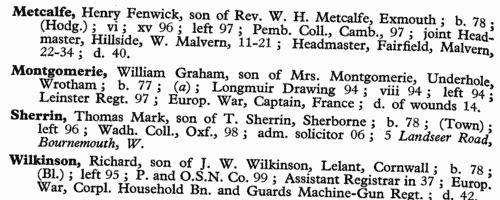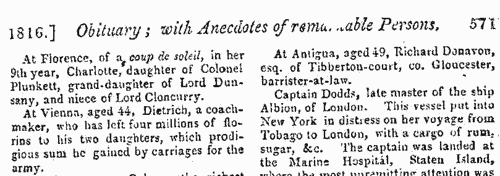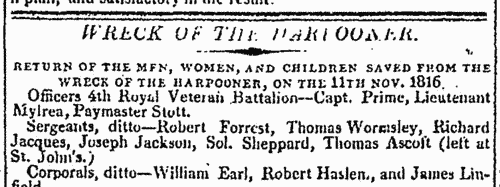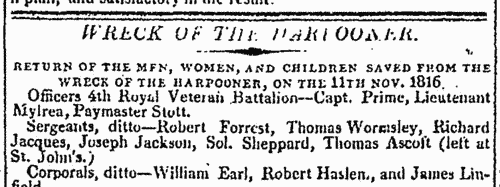Add this eBook to your basket to receive access to all 4,200 records. Our indexes include entries for the spelling davis. In the period you have requested, we have the following 4,200 records (displaying 1,711 to 1,720): These sample scans are from the original record. You will get scans of the full pages or articles where the surname you searched for has been found. Your web browser may prevent the sample windows from opening; in this case please change your browser settings to allow pop-up windows from this site. Wesleyan Methodist preachers
(1815)
A comprehensive list of Wesleyan Methodist ministers arranged by station and circuit in Britain, Ireland and abroad, was prepared each year at the church's annual conference. This includes supernumeraries and missionary preachers. | Sample scan, click to enlarge

| Wesleyan Methodist preachers' travel expenses
(1815-1816)
Major expenses incurred by Wesleyan Methodist preachers and reimbursed by the church are detailed in the annual accounts. The great majority of these expenses are the costs of moving to and between circuits, and give an indication of where a preacher has come from. There are also some items relating to serious illnesses and funerals. | Sample scan, click to enlarge

| Boys entering Sherborne School
(1816)
The grammar school at Sherborne in Dorset, which doubtless existed from the creation of the diocese of Sherborne in 705, was refounded by king Edward VI in 1550. At the quatercentenary in 1950, a fourth edition of the Sherborne Register was published, listing boys entering the school during those four centuries. In truth, the materials for this register survive but fitfully before 1823; for some years, no names are known; sometimes all that is known is a surname. But from 1823 onwards the lists and the details get steadily more comprehensive. By the 20th century the boys are listed alphabetically by surname under term of entrance. Surname is given in bold, then christian names, name of father (surname and initials) and address; year of birth; house (a, School House; b, Abbey House; c, The Green; d, Harper House (formerly The Retreat); f, Abbeylands; g, Lyon House; h, Westcott House); whether represented the school at cricket (xi), football (xv), shooting (viii), &c.; year of leaving; summary of degrees, career &c.; and (in italics), address as of 1950. Names in the early lists marked with an asterisk are found inscribed on the oak panelling or on the stone walls of the former schoolroom. (F) in the lists indicates a foundationer, receiving free education: after 1827, when this privilege was restricted to boys from Sherborne and neighbourhood, nearly all foundationers were day-boys. | Sample scan, click to enlarge

| Deaths, Marriages, News and Promotions
(1816)
Death notices and obituaries, marriage and birth notices, civil and military promotions, clerical preferments and domestic occurrences, as reported in the Gentleman's Magazine. Mostly from England and Wales, but items from Ireland, Scotland and abroad. July to December 1816.
| Sample scan, click to enlarge

| Deaths, Marriages, News and Promotions
(1816)
Death notices and obituaries, marriage and birth notices, civil and military promotions, clerical preferments and domestic occurrences, as reported in the Gentleman's Magazine. Mostly from England and Wales, but items from Ireland, Scotland and abroad.
| Sample scan, click to enlarge

| Lost in the Wreck of The Harpooner: 4th Royal Veteran Battalion
(1816)
Return of the men, women and children saved from and lost in the wreck of The Harpooner, 11 November 1816. Most were soldiers, their wives and children, from the 4th Royal Veteran Battalion, and the Royal Artillery, but also some from the 41st, 49th, 76th, 99th and 103rd regiments, as well as De Meuron's Regiment and the Glengary Fencibles. | Sample scan, click to enlarge

| Saved from the Wreck of The Harpooner: Royal Artillery
(1816)
Return of the men, women and children saved from and lost in the wreck of The Harpooner, 11 November 1816. Most were soldiers, their wives and children, from the 4th Royal Veteran Battalion, and the Royal Artillery, but also some from the 41st, 49th, 76th, 99th and 103rd regiments, as well as De Meuron's Regiment and the Glengary Fencibles. | Sample scan, click to enlarge

| Wesleyan Methodist preachers
(1816)
A comprehensive list of Wesleyan Methodist ministers arranged by station and circuit in Britain, Ireland and abroad, was prepared each year at the church's annual conference. This includes supernumeraries and missionary preachers. | Sample scan, click to enlarge

| Daughters of Wesleyan Methodist preachers
(1816-1817)
Children of Wesleyan Methodist preachers could be educated by the church at their schools at Kingswood and Woodhouse Grove. For each girl not educated at these schools 8 guineas was allowed by the church to her father; these sums are listed in the annual accounts, with the girl's full name, arranged by school year, giving us an idea of her age. | Sample scan, click to enlarge

| Wesleyan Methodist preachers' travel expenses
(1816-1817)
Major expenses incurred by Wesleyan Methodist preachers and reimbursed by the church are detailed in the annual accounts. The great majority of these expenses are the costs of moving to and between circuits, and give an indication of where a preacher has come from. There are also some items relating to serious illnesses and funerals. | Sample scan, click to enlarge

|
Research your ancestry, family history, genealogy and one-name study by direct access to original records and archives indexed by surname.
|











